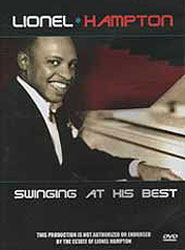 Lionel Hampton (1908-2002) continued to perform live into his great old age when he literally had to be wheeled out to his vibraphone, regarded as a living national treasure to the end. Lionel Hampton (1908-2002) continued to perform live into his great old age when he literally had to be wheeled out to his vibraphone, regarded as a living national treasure to the end.
He was still in his prime when he filmed the Snader telescriptions, three-minute movies to be shown on early television, at a time when it was expected that television programming would resemble radio programming, & the "records" spun would require pictures.
The telescriptions were all filmed in 1950, in two sessions easy to recognize because some of them have a rippled backdrop, & others are filmed in the "corner" of a stage backed up by a plain wall. The dates provided with the following reviews are the copyright dates from the title cards of the individual films, which are release dates in 1950, 1951, & 1952.
We're seeing the Lionel Hampton Orchestra which he founded in 1940 after leaving the Benny Goodman Orchestra, though even while with Goodman he moonlighted with his own combos which he also called his Orchestras.
In the early '40s his orchestra was closest to familiar big band swing. But within five years, by 1945 latest, his band had evolved to a sound that presaged Rhythm & Blues, drawing more & more on jump-jazz.
Hampton had a mystical side & came damn close to converting to Judaism around the time these telescriptions were made (he even received the Israeli Statehood Award in 1958). In the long run, though, he became a Christian Scientist, & a Freemason.
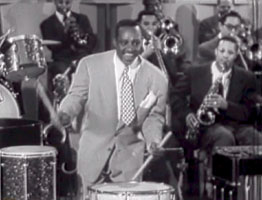 For Beaulah's Boogie (1950) Lionel Hampton strikes a couple starting notes on the vibraphone, a boogie piano starts up, & behind Hamp the band is clapping hands, not yet playing their instruments.
For Beaulah's Boogie (1950) Lionel Hampton strikes a couple starting notes on the vibraphone, a boogie piano starts up, & behind Hamp the band is clapping hands, not yet playing their instruments.
We're entering a filmed-live version of a rapid, a new arrangement of a jumping instrumental which had reached #2 on R & B charts in 1945.
Hamp saunters over to the tomtom & grabs a couple of sticks. He begins drumming just as the band pipes in. He's got a stubby (wide & short) pokadot tie & fantastic personal charisma.
The camera lingers on the "other" drummer in back then pans right for the trumpeter's solo, then tracks further right to a high-note trumpeter, then to a wailing sax solo.
By then Hamp's returned to his vibraphone for his own solo/lead. What a handsome face he has in the close-ups. He shouts "Hey!" then goes jauntily back to the tomtoms, juggling the sticks during the close, & at the last moment jumping with both feet atop the shorter tomtom.
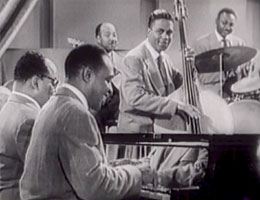 The Snader telescription T.V. Special (1951) with Lionel Hampton & His Orchestra can be a little confusing by the title, as it's the name of the boogie number, not some clip from a television show.
The Snader telescription T.V. Special (1951) with Lionel Hampton & His Orchestra can be a little confusing by the title, as it's the name of the boogie number, not some clip from a television show.
It starts off with Hampton's two-finger piano solo while the band looks on with rapt expressions.
Momentarily the drum & slap-bass add a stronger boogie beat, & most of the rest of the band claps hands, as Hamp boogies with all his fingers, joined by a second pianist on the long piano bench, so that four hands are at it.
The second pianist on one piano is jazz legend Milton Buckner (1915-1977), who appears in all the telescriptions. This is simply an amazing arrangement, not at all gaudy, but rather elegant in these two men's swiftness along the keys.
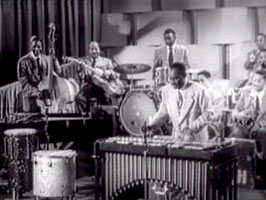 The Snaders were filmed in two distinct sessions. One batch was filmed in front of an unusual "rippled" backdrop, including Vibe Boogie, Beulah's Boogie, Cobb's Idea, & Midnight Sun.
The Snaders were filmed in two distinct sessions. One batch was filmed in front of an unusual "rippled" backdrop, including Vibe Boogie, Beulah's Boogie, Cobb's Idea, & Midnight Sun.
The other session was filmed on a stage that looks like the "corner" of a large room with plain walls, including Ding Dong Baby, Love You Like Mad Love You Like Crazy, Slide Hamp Slide, Air Mail Special, & Bongo Interlude.
Though they were all filmed in 1950, they were released at intervals, so that Midnight Sun (1952) carries a later copyright date on the title card. Along with Beulah's Boogie, this was recycled into Showtime at the Apollo: Showtime in Harlem (1955).
The faked Apollo concert version, that included other Snader telescriptions by Nat "King" Cole, the Delta Rhythm Boys, & Martha Davis, has the soundtrack tinkered with to add audience reactions, though these live performances were actually on a soundstage & the version circulating with the original title cards have no such intrusions.
The titular tune for the telescription Midnight Sun was written by Johnny Mercer, Lionel Hampton & Sonny Burke. Lionel is at his vibraphone in front of the orchestra, starting it off alone, an exotica piece evoking tropicalism more than northern night-time sunlight.
Hamp's trombonist Benny Powell steps out of the orchestra & begins to play oh such mellow notes, the slide reaching right over the vibraphone. He finishes his solo & returns to the orchestra which raises its own sound as Hamp stops playing his instrument momentarily to conduct with the mallets.
It's then right back to vibraphone dominance, at a more rapid pace, Hamp practically but not quite dancing where he stands, conveying as he often does an abject joy for the music.
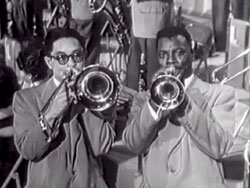 A big band swing arrangement has plenty of brass for the jump-jazz number Love You Like Mad, Love You Like Crazy (1951). Lionel Hampton conducts with back to band & smiling ear to ear. His joy of the music is always infectious. A big band swing arrangement has plenty of brass for the jump-jazz number Love You Like Mad, Love You Like Crazy (1951). Lionel Hampton conducts with back to band & smiling ear to ear. His joy of the music is always infectious.
Unlike the soundies of the 1940s, the telescriptions were rarely about the cheesecake, much more purely about the music, & so rarely decorated with gorgeous babes unless they're the musicians or singers.
Hampton however liked a little sexiness in his stage act, & in this telescription we see beautiful women seated near the band, attentively absorbing the music. Momentarily they stand up & go stand in a line beside Hamp, swaying with him. Among these women are singers Betty Carter & Irma Curry, though none of the group sing in this telescription.
To the first gal in the row of six, Lionel begins to sing: "I love you like mad/ I love you like crazy/ I love you like everything/ Can't get over this feelin'/ I'm a whirlin' & a reelin'/ And the time of the year is great."
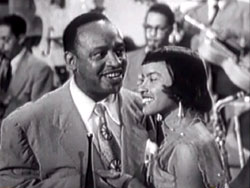 The next girl in line steps up to Hamp for the next verse: "I love you so bad/ I love around hazy/ Baby to you I cling/ Now my poor heart is thumpin'/ Full of butterflies & jumpin'/ And I feel like I want to sing." The next girl in line steps up to Hamp for the next verse: "I love you so bad/ I love around hazy/ Baby to you I cling/ Now my poor heart is thumpin'/ Full of butterflies & jumpin'/ And I feel like I want to sing."
Then to the third girl in line: "I can't get over this love kick/ I even get lovesick about you/ Honey I'm nothing without you/ I want you to know, oh, I repeat it.
And to girl number four: "I love ya like mad/ I love ya like crazy/ I love you like everything/ Man I know that I'm livin'/ When I see that you're givin'/ Lots & lots of sugar to me/ I love you baby, I love you till I'm crazy/ I love you like mad."
The big brass sound of the orchestra rises anew, with Hamp leading on vibraphone. A trombone & high-note trumpet do a bit of a duel which is just tres cool. For close, Hamp reprises a line of the lyric.
This is a strong wee film because it's a strong big performance. Hamp should've sung more often as he had a voice full of character & charm.
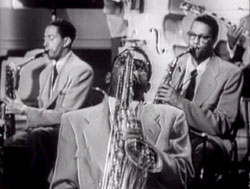 Right off the bat there's a vibraphone solo, with the band behind Hampton clapping hands, in Ding Dong Baby (1951), a nice bit of up-tempo jazz.
Right off the bat there's a vibraphone solo, with the band behind Hampton clapping hands, in Ding Dong Baby (1951), a nice bit of up-tempo jazz.
Soon the brass & reeds join in, then Hamp moves from the vibraphone to the microphone to sing a delightful bit of jump-jazz reminiscent of Louis Jordan, with even a bit of call & response with his band:
"I gotta gal; she lives on the hill/ I want to quit her but she's my thrill/ She's my ding dong baby (ding dong baby)/ She's my ding dong baby (ding dong baby)/ She's my ding dong baby & she knows how to ring my bell."
A beautiful babe strolls out to join Hamp for her decorative value, as he continues: "Here come my gal, she look so sweet/ Everytime I see her I go tweet, tweet, tweet/ (She's my ding dong baby) ding dong baby!/ (She's my ding dong baby) ding dong baby!/ She's my ding dong baby & she knows how to ring my bell."
Jump-jazz was the rock & roll of the '40s & Hampton's band comes awfully close to completing the bridge to outright rock 'n' roll, especially when the instrumental break is fired off with a saxophone solo suitable for either rhythm & blues, or '50s rock. Then out comes Hamp's top trombonist Benny Powell for a rousing duet with the sax, & man oh man can you dance to that!
"Mama mama, look at sis/ She's out in the back yard having a fit/ She's my ding dong baby (ding dong baby)/ She's my ding dong baby (ding dong baby)/ She's my ding dong baby & she knows how to ring on my bell. Yeah!"
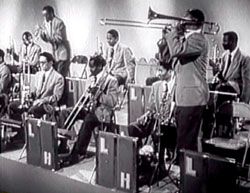 Hamp's put on his sea captain's hat for Slide, Hamp, Slide (1951) & opens this number at his tomtoms. Hamp's put on his sea captain's hat for Slide, Hamp, Slide (1951) & opens this number at his tomtoms.
The number was first recorded in 1944 & released in December 1945 as the flipside of archly beatnik "Hey! Ba-Ba-Re-Bop," which hit the R & B charts in 1946. The 1951 live performance of Slide, Hamp, Slide is a very different arrangement from the previous B-side recording.
The orchestra is just getting started on a swift easy beat reminiscent of a train on a track. Hamp hits the vibraphone almost as an announcement for a trumpet solo, followed by trombone. It becomes a duel between trombone & slide vibraphone, hence the "slide."
At one long measure, trombones are "talking" like "gabble gabble woot" & between riffs the entire band is going "jadda bodda bodda wadda jow wow," with Milt Buckner bouncing at full tilt on his piano bench. It's all just brilliant fun.
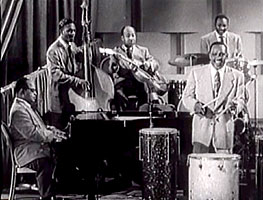 Juggling drumsticks, Hampton is at his tomtombs, his orchestra soon joining in for Cobb's Idea (1951), alluding to saxophonist Arnett Cobb who had been in the Lionel Hampton band from 1942 to 1947. It was something of a signature song for Arnett when he left Hamp & formed his own band Arnet Cobb & His Mobb.
Juggling drumsticks, Hampton is at his tomtombs, his orchestra soon joining in for Cobb's Idea (1951), alluding to saxophonist Arnett Cobb who had been in the Lionel Hampton band from 1942 to 1947. It was something of a signature song for Arnett when he left Hamp & formed his own band Arnet Cobb & His Mobb.
Hamp stops drumming & conducts until he decides to head over to his vibraphone. A trumpet solo heralds a big sound from reeds & brass, then out comes vocalist "Betty Bebop" Carter to perform some hot, amazing scat. This is a fabulous vocal solo.
Betty was born Lillie Mae Jones from Flint, MIchigan, & was only sixteen years old when she sang for Charlie Parker, having lied about her age to get the gig.
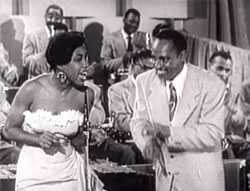 She toured not only with Hampton but with Miles Davis & Dizzy Gillespie & was part of the birth of bebop. She continued performing into her sixties, & President Clinton awarded her the National Medal of Art the year before she died. She toured not only with Hampton but with Miles Davis & Dizzy Gillespie & was part of the birth of bebop. She continued performing into her sixties, & President Clinton awarded her the National Medal of Art the year before she died.
Hampton himself preferred swing & jump-jazz & only used Betty sparingly for these rare "bebop scat" moments, & never cut a full song with her doing lyrics. She & Hamp came to verbal blows over his refusal to provide arrangements she could sing, but he was insistent she remain exclusively "Betty Bebop" & do absolutely nothing else.
According to legend, over just such disagreements he fired Betty seven times in the two & a half years she was with the band. But Hamp's wife Gladys Neal Riddle (who was the band's manager, a song composer, & a savvy investor who insured she & Hamp would never go needy) adored Betty, treating her like a daughter, & kept hiring her back. He obviously relented for "Cobb's Idea" & let her have her own way vocally.
When Betty's done scatting, the trombone takes over the sound as though a trombone can scat, too. Then that amazing sax player Bobby Plater gets a solo, & Milt is bouncing so hard on his piano bench it seems like he might suddenly fly into the sky. The whole performance is like a dream of the Harlem Renaissance reborn.
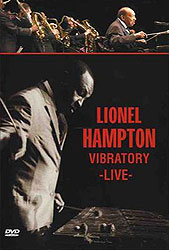 The Snader telescriptions have been circulated in two versions, the original with Snader Studio title cards at the start of each mini-movie, & stitched into trumped up "concerts" a half hour each of numerous performers who were filmed between 1950 & 1954. The Snader telescriptions have been circulated in two versions, the original with Snader Studio title cards at the start of each mini-movie, & stitched into trumped up "concerts" a half hour each of numerous performers who were filmed between 1950 & 1954.
These selections of telescriptions existed in half-hour combinations for syndication to television, & at feature lengths for theatrical release, mostly in 1955.
These have since been dismantled into their original components, & can be found scattered on various dvd compilations as clips or as separate mini-movies.
The soundtracks on those versions are somewhat altered in order to support the illusion of concerts live at the Apollo Theater in Harlem (Hamp's telescriptions were really filmed on a sound stage at California Studios in L.A., live performances but not with an audience).
So there applause & even laughter can be heard on these re-edited versions, sometimes even bits of the emcee Willie Bryant pretending all the performances are on the same stage with himself, & cutaways to an audience that wasn't actually there.
T.V. Special together with Slide, Hamp, Slide were recycled into the half-hour telescription package Showtime at the Apollo: Jazz Time (1955). Ding Dong Baby & Slide, Hamp, Slide were recycled into Showtime at the Apollo: All Star Revue (1955). Slide, Hamp, Slide was again used in Showtime at the Apollo: Jazz Time (1955) together with Air Mail Special.
Beaulah's Boogie & Midnight Sun were spliced into Showtime at the Apollo: Showtime in Harlem (1955). Cobb's Idea became part of both Showtime at the Apollo: Rhythm in Harlem (1955) & Showtime at the Apollo: Variety Time (1955).
Two more telescriptions, Vibe Boogie (1951) & Bongo Interlude (1951), are part of the feature-length theatrically released Rhythm & Blues Revue (1955), & those two are reviewed with that film. They were also part of Showtime at the Apollo: Variety Revue (1955).
It's better to see the original versions from the initial Snader releases, as they don't have the audio & visual intrusions of the re-edits. Fortunately the original mini-movies are indeed the ones to be found on the following compilations:
Most of Hamp's telescriptions can be had on the compilation disc Jazz-o-Logy: Hamp & the Duke (2004) which is the same as Big Bands Volume 1: Duke Ellington & Lionel Hampton (1988), issued also as Swing Era: Duke Ellington, Lionel Hampton (2004).
Separate from the Ellington telescriptions, Hampton's can also be had, along with a few other filmed performances, on Lionel Hampton: Swinging at His Best (2005), or the overlapping Lionel Hampton Vibratory Live (2006).
copyright © by Paghat the Ratgirl
|
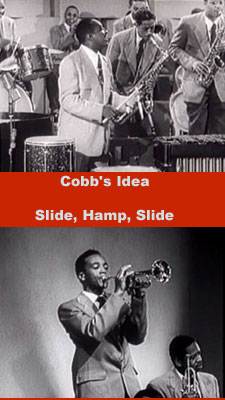





 The next girl in line steps up to Hamp for the next verse: "I love you so bad/ I love around hazy/ Baby to you I cling/ Now my poor heart is thumpin'/ Full of butterflies & jumpin'/ And I feel like I want to sing."
The next girl in line steps up to Hamp for the next verse: "I love you so bad/ I love around hazy/ Baby to you I cling/ Now my poor heart is thumpin'/ Full of butterflies & jumpin'/ And I feel like I want to sing."


 She toured not only with Hampton but with Miles Davis & Dizzy Gillespie & was part of the birth of bebop. She continued performing into her sixties, & President Clinton awarded her the National Medal of Art the year before she died.
She toured not only with Hampton but with Miles Davis & Dizzy Gillespie & was part of the birth of bebop. She continued performing into her sixties, & President Clinton awarded her the National Medal of Art the year before she died.